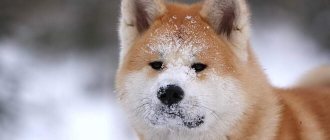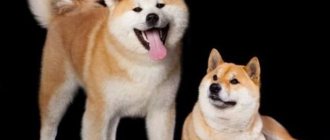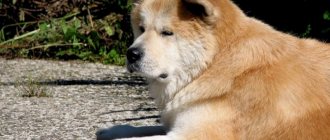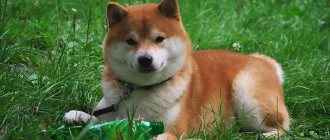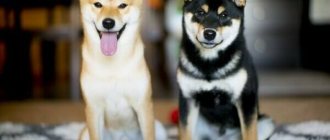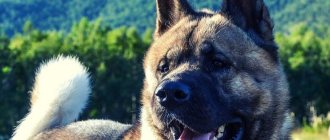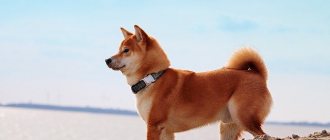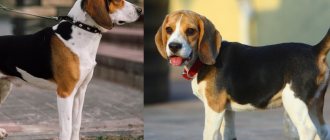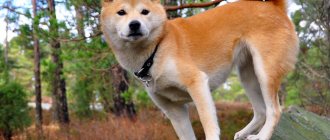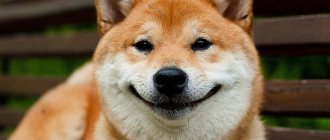However, there are species that, to a person not versed in cynology, at first glance may seem absolutely the same. Some of the representatives of this category are the Akita Inu and Shiba Inu breeds.
Origin of the Akita Inu and Shiba Inu breeds
Akita Inu and Shiba Inu are Japanese breeds. Inexperienced dog breeders do not always see the differences between them. Although both varieties belong to the category of the oldest, the origin of the Akita Inu dates back to the second millennium BC, and the Shiba Inu (Shiba Inu) - to the third century BC. e.
Read a more detailed description of the Shiba Inu breed here.
The Akita Inu has a feature that is highly valued by dog breeders - it was created by nature and not artificially bred. Its representatives began to live near humans thanks to the diligent process of domestication. Akita Inus were pampered in every possible way, and their own servants were assigned to them. The wide distribution of individuals throughout Japan increased their numbers, endurance, and intelligence. These qualities led the Japanese to the idea of using the Akita in warfare. But by the end of World War II, only a few Akita Inu remained. Japanese dog breeders have made every effort to preserve the breed.
This is interesting: Pros and cons of the Akita Inu breed
Shiba Inu, unlike Akita, is the result of selection. It was brought to Japan by immigrants from Korea. Further crossbreeding with local breeds has put the Shiba in danger of extinction. In the twentieth century, the government became serious about preserving the Shiba Inu. For this purpose, purebred representatives were selected. In 1934, the Shiba Inu breed standard was approved, and in 1936 it was made a national treasure of Japan. The Fédération Cynologique Internationale recognized this variety in 1964. Today, the Shiba Inu remains one of the most popular companion dogs in many countries.
Character
Typically, Japanese people can describe the Shiba Inu's character in three words: brave, friendly and charming.
Such incompatible qualities coexist in one pet the first time. These are brave creatures with excellent intelligence and prudence.
Friendly Shiba Inu are very innocent and docile in front of their owner, although they are prone to self-centeredness and maximum manifestation of leadership qualities.
Often the Shiba Inu is characterized by a love of freedom and a stubborn disposition, so the owner should show persistence and firmness when raising the puppy from the first day.
To ensure that the dog obeys its owner, nurseries begin socialization from an early age, correcting the habits and behavioral characteristics of arrogant puppies.
Despite their independence, these are quite disciplined dogs. Leaving more natural instincts, qualified breeders in nurseries make their character softer.
The dog may ignore the owner's command if it finds it uninteresting. They treat the owner with love and devotion, but do not tolerate excessive tenderness towards themselves.
Although even as adults they love to frolic like puppies . They can commit minor pranks and then beg forgiveness from the owner with an innocent look.
It is also worth paying attention to the facial expressions of the Shiba Inu. With their charming smile, they are able to express a whole range of emotions: mockery, cheerfulness, devotion and even indignation.
It is rare to see Shiba Inus barking; alternatives to this are specific sounds: grunting, squealing, howling and even laughing.
Despite the modest description of the size of dogs of this breed, they show good watchdog qualities.
They are able to control the situation, rushing to stand up for the owner and their own territory. They try not to miss a single sound.
They actively participate in all home activities. Shiba Inus are supporters of both calmness and balance, as well as active interaction with all family members.
Difference
Most people who don't understand dogs can't always tell the differences between a Shiba Inu and an Akita Inu. But if you put them side by side, the differences will be obvious.
In appearance
The first thing that catches your eye is the size.
| Height (cm) | Height (cm) | |
| Akita Inu | 60-70 | 30-40 |
| Shiba Inu | 35-40 | 8-10 |
Shiba Inu is 2 times smaller. Other differences are less noticeable. The standard provides for the following types of Akita colors:
- red-fawn;
- sesame (wool with black tips);
- brindle;
- white.
The Shiba Inu has the same colors, with the exception of white. In practice, both breeds have all color options.
Dogs have differences in the structure of their coat: the Shiba Inu has a thick coat, but it is tougher compared to the Akita Inu. They also have a thicker and denser undercoat.
In care
Caring for an Akita Inu and a Shiba Inu is not significantly different. The breeds require careful care of their coat. Both species shed twice a year. During this period, Akita Inu and Shiba Inu need daily brushing; at other times, 2-3 times a week is sufficient. The Shiba's coat is less fluffy, which makes grooming easier.
The Shiba Inu is cleaner than the Akita Inu. She is bathed no more than once every six months; an Akita may need 3-4. Both dogs' eyes and ears are regularly wiped with a damp cloth, and the length of their nails is monitored.
Both breeds require the same walking regimen - at least twice a day for 1.5-2 hours. Akita Inu and Shiba Inu need physical activity. It is necessary to let your dog off the leash periodically.
An important difference in caring for the two breeds is nutrition. Not just any dry food is suitable for Akitas. Since they are of truly Japanese origin, rice, fish, seaweed and seafood are more suitable for them. If the owner prefers ready-made food, then, in order to avoid problems with the dog’s health, it is better to consult a veterinarian.
This is interesting: 8 distinctive features of Japanese dogs
Shiba Inu can eat premium and super premium dry food. You can choose a natural diet for them, but you must carefully observe the proportions: 30% protein to 20% fat.
In price
The cost of Akita Inu and Shiba Inu puppies depends on the class:
- Show. This category includes standard dogs, without flaws. They are used for exhibitions and breeding.
- Breed. Puppies with good reproductive performance, but with slight anatomical deficiencies. They are suitable for breeding, but do not always win at shows.
- Pat. These puppies have deviations from the standard or defects (not life-threatening or health-threatening). They are unsuitable for exhibitions and breeding.
The cost of Akita Inu puppies in Russia varies from 5 to 80 thousand rubles. The presence of a pedigree raises the minimum price to 35 thousand. You will have to pay much more than the average cost for a show-class dog. Pet Akita Inu can be purchased from an ad on the Internet from 10 thousand.
Buying a Shiba Inu will also not be cheap for the future owner; its price is much different from the cost of an Akita Inu - from 15 thousand for a pet to 80 thousand or more for higher classes. The average price in Russia for Shiba Inu puppies is 60 thousand rubles.
Males of both breeds can be purchased for 10 thousand less. Bitches are in great demand, which determines their high price. You can save even more by purchasing an adult dog. But in this case, you need to understand that her character has already been formed and it will be difficult for her to get used to the new owner and environment.
Care and maintenance
The sleeping place for a puppy and an adult dog is arranged not on the move, not in a draft, not near a radiator and away from bright directional light. Shiba puppies are clean, they just need help with this. It is necessary to allocate a place for the toilet away from his bed. After the course of vaccinations, take the puppy outside every 3-4 hours.
You should not go for a walk immediately after eating - active movements with a full stomach are also harmful for an adult dog.
The health of the coat will be maintained by weekly brushing. Twice a year both the outer coat and the undercoat shed - then they do not pluck it, but comb it out.
The dog, washed with neutral shampoo, is blotted with a towel and dried with a hairdryer. Ears, claws, and teeth require regular examination.
The Shiba Inu is not picky when it comes to nutrition, but the diet must be composed correctly. It is worth listening to the experience of the breeder and the advice of the veterinarian, do not feed “from the table”, and follow the established feeding regime.
Shiba should always be able to move. Walk a lot, and play at home.
A regular walk with such a dog is impossible - it needs additional physical exercise.
Similarities between Akita Inu and Shiba Inu
The similarities between the Akita Inu and the Shiba Inu are much greater than the differences. Externally, they differ only in size. Otherwise, the exterior and anatomy of the dogs are similar: an elongated muzzle, triangular and pointed ears, brown and slightly slanted eyes, thick fur, a thick tail, strong jaws and strong limbs.
Puppies of both breeds are very playful and playful in childhood. The difference is that with age, the Akita Inu becomes calmer, while the Shiba Inu can behave the same way throughout its life as it did in childhood. Both dogs are quite disciplined and relatively easy to train. Although the Shiba can show some waywardness.
The Akita Inu and Shiba Inu breeds are clean and do not have the characteristic dog smell. Both dogs are smart and never bark in vain. At the same time, they become very attached to their owner and will always stand up for him. With proper upbringing, Akita and Shiba grow up to be friendly and ready to generously shower their owners with love.
Interesting article: American Akita: characteristics and description of the breed
What to do if the parameters lag behind the norm
After a puppy has been taken to a new home and taken away from its usual environment and mother's milk, its growth may slow down.
To prevent this from happening, puppies can be given calcined cottage cheese along with a small amount of whey, one yolk and two drops of multivitamins.
IMPORTANT! In a month, a healthy puppy doubles in size.
Worms may be the cause of stunted growth and weight gain. The first anthelmintic is given before the first vaccination at two months. The necessary drug must be prescribed by a veterinarian.
If the lag in the pet's height and weight is very noticeable in comparison with its relatives, the same puppies, you should pay attention to vitamin supplements. The veterinarian will tell you which vitamin complexes to choose.
Akita Inu dogs are leisurely. They take a long time to grow and are in no hurry to mature. The Akita reaches full physical development only at three years of age.
Description of the breed standard
According to the 1992 standard, the Shiba Inu dog must have the following characteristics:
The height and weight of an adult male is 38-42 cm, 9-14 kg; for females these parameters are 35-38 cm, 8-13 kg.
The muzzle is a little plump, pointed, similar in shape to a fox. The lips are not wide, the jaws are strong and have a steel bite.
The eyes are small, slightly slanted, triangular, the color of dark chocolate. The ears are pointed, small, and the ends are slightly tilted forward.
The neck is lean, low, harmonious with the head and body. The loin is straight and strong. The chest is deep, the tummy is well retracted.
The forelimbs are straight. In the hind limbs, the upper part is longer than the lower.
The coat is short, thick, hard (the undercoat is softer). The following varieties of Shiba Inu color are distinguished: zoned (a small percentage of the fur is colored black), black with red or steel tan, red.
The first type of color can be with a predominance of white - white sesame; black - black sesame; red - red sesame. The deep red color has the advantage.
All colors, with the exception of white, must be lightened on the underside (the so-called urahiro).
Who is better to choose
The strong similarity of the two breeds often gives rise to the question of who is better to have, an Akita or a Shiba. When choosing, you need to focus on many factors: place of residence, free time, physical activity, training experience, presence of animals and children.
Akita Inu will be an ideal choice for people:
- living in a private house;
- having no animals or children;
- able to devote a lot of time to the pet;
- looking for a dog to be a guardian and a hunting assistant.
In turn, the Shiba Inu is perfect for those who:
- lives in an apartment;
- physically active (this will be needed during walks);
- able to show patience in training or already has experience;
- contains other animals;
- raises children.
Expert opinion
Anna Abramenko
An avid dog lover. Experience in veterinary medicine since 2009.
Ask a Question
This comparison is conditional. Both breeds are active, friendly, and strongly attached to their owner. A dog's behavior depends, first of all, on the quality of its upbringing. Even the most restless puppy can be turned into an intelligent and patient animal with the help of training.
Future owners should approach the choice of a puppy responsibly. Under no circumstances should it be presented as a gift. Each person must make his own decision about the degree of responsibility he is willing to assume.
Dog handler's opinion
“The Shiba Inu is a representative, albeit similar to the Akita, but still a different breed. These are medium-sized dogs, mostly bright red in color, distinguished by a bold, but at the same time balanced and calm disposition, intelligent and friendly towards their owners. They are better suited for living in an apartment than their larger “relatives,” but you need to remember that these dogs need significant physical activity.
It’s not difficult to keep a mini Akita, but you need to take into account that these dogs need a special diet, since during the long isolation in their historical homeland, the Shiba Inu has developed special taste preferences.”
Upbringing
There will be no harm from an obedience course with a competent instructor, but the main thing in the education process will be:
- establish contact with the dog, hear it and teach it to hear itself;
- socialize your pet from young claws.
Raising a Spitz requires flexibility.
Characteristics of the Shiba Inu breed include an innate increased activity. It needs to be extinguished smoothly, but only excessive activity needs to be extinguished - when the dog is so carried away that it cannot stop itself. Constant tugging can turn an active Shibu into a cowardly, nervous or indifferent one.
Another thing is the satisfaction of activity through games, exercises, and exploration of new territories. It’s useful to stock up on an arsenal of fail-safe “switches” for your dog’s attention.
It is better to start socialization as early as possible. Do not force contacts, but provide the puppy with the opportunity to establish them. Do not interfere with harmless group games, touch little Siba more often, so as not to grow touchy.
While walking, it is useful not to be distracted from the dog. She always watches the owner, waiting for his hint, obvious or hidden.
The flock's territory requires protection . The one who first noticed the threat of violating its boundaries should immediately inform others about it. It is clear that this “first” in the family will be Siba.
You should not scold the dog if its ringing voice woke up the neighbors, even if the alarm turned out to be false (in the human opinion). She, too, was sleeping, and not preparing a prank, she also woke up and saved her flock. A vigilant friend awaits approval. (It is the owner’s task to explain to the neighbors that their house is also in the zone of attention).
The dog will not make noise for a long time - he uses prolonged “barking” only when hunting. It won't hurt to learn the silence command.
Reviews
Maria, Moscow: “I’ve been training Akitas for 7 years. And for me there is no better dog in the world. I can talk about them for hours. Akita is proud and independent, but also an excellent companion. I wouldn’t trade such a dog for any other breed.”
Elena, Yaroslavl: “When choosing a puppy, we settled on a Shiba Inu and have never regretted it. The dog got along well with children and our other animals. Owners of this breed are definitely the happiest owners.”
Kirill, 29 years old, Novosibirsk: “Initially I wanted to buy an Akita Inu. But after getting to know the breed in detail, I decided that for my conditions the Shiba was a more suitable option. The dog is willful, but proper training and patience make it an ideal pet.”
Training
Representatives of this breed have a fairly good character. They are patient, obedient and receptive to everything new. With the right approach, the Akita Inu will become an excellent guard. To do this, you need to engage in training from the first days of arrival in the house. The puppy is taught to behave correctly, is not allowed to spoil the environment in the house, and basic commands for obedience are taught to him.
Important! For beginners, it is better to seek help from a dog handler. Akito Inu is a dog that needs a clear hierarchy
If the owner does not take a leadership position, problems with obedience will arise. When training, one feature must be taken into account - representatives of the breed are distinguished by vindictiveness and therefore violence cannot be used as education
The Akito Inu is a dog that needs a clear hierarchy. If the owner does not take a leadership position, problems with obedience will arise. When training, one feature must be taken into account - representatives of the breed are distinguished by their vindictiveness and therefore violence cannot be used as education.
In order for the Akita Inu to guard and protect the home, it is specially trained. It is better to do this at specialized sites and under the guidance of a dog handler.
If desired, dogs can be used for hunting. They will be excellent companions and will defeat any beast.
Keeping at home
The Shiba Inu is more suitable for keeping at home due to its small size, but at the same time, it needs to be constantly dealt with and taught norms of behavior.
A stubborn disposition can only be broken at a young age. Caring for a Shiba Inu puppy will not create any big problems.
It is important to choose the right resting place for your pet. It should not be in a draft or near heating equipment.
A special bed lined with thick fabric made from natural materials is perfect for these purposes.
Shiba Inus prefer peace and quiet, but at the same time want to be aware of all events.
It is best to choose a place for a bell guard in the corridor, where there is a view of the rest of the rooms. To prevent your puppy from damaging shoes, furniture, books and other items, you should purchase rubber toys for him in advance. Array
Suitable nicknames
For boys you can choose:
- Abaris, Abdul, Abiz, Aden, Adonis, Alf, Ador, Alamo, Amber, Arnold, Alvaro, Iron, Agate, Akari, Aramis, Arden;
- Barney, Bilbo, Brian, Bruce, Bregon, Black, Byron, Benjamin (Ben), Brutus, Boyar;
- Dakar, Danny, Dustin, Dexter, Dandy, Draco, Dingo (Dean), Dollar, Don;
- Maestro, Martin, Max, Mickey (Mick), Merlin, Morgan, Maurice, Misha;
- Parsifal (Parsi), Pedro, Pluto, Poseidon, Pinko;
- Ralph, Ramon, Ram, Ringo, Rubin, Rafael (Raph);
- Hachiko.
For girls:
- Adelaide, Aika, Albina, Alma, Allegra, Annabelle, Andromeda, Akanawa, Ariel, Astra, Arista, Azalea, Alaska, Alexis, Aretha, Arina, Assyria, Aurora;
- Olympia, Ohana, Ocher, Opia, Okima;
- Salma, Samira, Sati, Savannah, Sierra, Cynthia, Santa, Suliko;
- Esmeralda, Estima, Aetola, Erinia, Evernia.
Description of appearance
Mini Doberman (dwarf): what is the name of the breed
Akita Inu were originally used by monks to guard and protect monasteries 3,000 years ago and were strictly careful to ensure that the breed did not get outside the monastery walls. Then the local population adapted dogs for hunting large animals (boar, bear).
Akita Inu is the smallest of the Japanese hunting dogs, but far from the smallest among its relatives. Her height at the withers is 61-67 cm, weight 40-50 kg. For those living in high-rise buildings, it is not very comfortable to have a dog of this size in an apartment, so a smaller copy of it was produced, the appearance of which corresponds to the original, but half the size. The small Akita is called like a Shiba Inu. Translated from Japanese, it means “little bush dog.”
Main characteristics of the Shiba Inu:
- body – muscular, somewhat elongated;
- height – 38-40 cm;
- weight – up to 10 kg;
- back – straight, strong;
- neck – muscular, strong;
- head – has a wide skull;
- chest – wide, ovoid;
- nose – black;
- eyes – dark brown, slightly slanted, almond-triangular in shape;
- ears – medium size, erect;
- the coat is straight, thick, hard, needle-shaped with a soft undercoat;
- paws – strong, muscular, the angle between the humerus and the front paws is 110-120 degrees;
- the tail is strong, curled into a ring. It is not allowed to untwist the ring, lower the tail or lay it on the dog's croup.
Breed standard
The Little Akita has a mostly red coat color, white and brindle are also acceptable. The tiger color can range from a light silver shade to almost black. Black and tan dogs have a bright white butterfly on their chest.
Important! The red coat color can have different shades from light sesame, red sesame (blackening of the fur at the tips) to bright red.
The Mini Hachiko breed has a distinctive feature – urajiro. This means that the area of the chest, belly, lower neck and tail, cheeks, chin, and inner surface of the paws are white. The transition from light to dark color should be gradual.
Characteristic
Akita Inu is a companion dog of a discreet nature, in the FCI classification it belongs to Spitz and related primitive breeds. There are no performance tests for dogs.
Breed standard FCI No. 255
Akita Inu is a balanced dog, quite large and noble in appearance. He behaves with restraint and obedience, without aggression.
Head size in proportion to the dog's body. The frontal part is wide, without folds. There is a pronounced groove on the Akita's forehead, and a stop line is also noticeable. The muzzle is of moderate length - the base is wide, slightly tapering towards the black lobe. Partial depigmentation of the lobe is acceptable for light-colored dogs. The teeth are moderate, even, covered with dense lips - a scissor bite.
At the level of the stop, the eyes are almost triangular in shape. The outer corners are raised relative to the inner ones. Eye color is dark brown. The erect ears are set moderately wide at the top of the skull and covered with a layer of dense, soft hair. Slightly inclined towards the muzzle.
The neck is thick, without dewlap, covered with a voluminous collar, flowing into the line of a strong back. The chest is deep, the ribs are slightly curved, the belly line rises up from the chest to the groin area. The croup is completed by a thick tail set high. It is twisted into a ring and thrown as far as possible onto the back.
The paws are thick and strong, the toes are arched, gathered into a dense ball. The elbows of the forelimbs are tightly pressed to the body, the hock joints of the hind limbs are developed, due to which the dog moves elastically and quickly.
Other deviations leading to disqualification:
- snack, undershot;
- incomplete dental formula;
- short tail;
- aggressiveness, timidity;
- blue or black spots on the tongue;
- excessively long hair;
- drooping ears;
- black mask on the face;
- spots with white color.
Dimensions, weight and height of the breed
The permissible weight for Akitas is not specified in the standard - breed experts focus on the proportionality of the animals. The height for males should be up to 67 cm, for females - up to 61 cm, while the body proportions are as follows - the height is 10/11 of the length of the body.
Breeders note that the weight of males reaches 59-65 kg, females - 32-45 kg.
Possible colors
The Akita Inu has a straight coat - the guard hair is coarse, and the undercoat is soft and downy. The length of the coat is medium, slightly higher on the tail, withers and rump area.
Types of colors allowed for Akita Inu:
- white;
- brindle;
- red-fawn;
- sesame is an analogue of red-fawn, with dark ends of hair.
With all types of color, representatives of the breed have whitish hairs on the face - in the area of the cheekbones, lips and lower jaw. There are also such hairs on the body - they are called “urajiro”.
Puppy weight by month
Weight differences between Akita Inu females and males appear from childhood. The owner must monitor the development of the puppy and, if necessary, adjust the diet.
Weight-to-height ratio for Akita females:
- 1 month – 2.7 kg;
- 2 months – 5 kg;
- 3 months – 9.5 kg;
- 4 months – 12.5 kg;
- 5 months – 15.5 kg;
- 6 months – 17.5 kg;
- 7 months – 19 kg;
- 8 months – 20 kg;
- 9 months – 21.5 kg;
- 10 months – 21.5 kg;
- 11 months – 22 kg;
- 12 months – 25 kg.
Weight-height ratio for male Akita Inu:
- 1 month – 2.7 kg;
- 2 months – 7.5 kg;
- 3 months – 15 kg;
- 4 months – 20 kg;
- 5 months – 25 kg;
- 6 months – 30 kg;
- 7 months – 32.5 kg;
- 8 months – 35 kg;
- 9 months – 36 kg;
- 10 months – 37 kg;
- 11 months – 37.5 kg;
- 12 months – 38 kg.
Indicators are approximate and vary depending on the physical parameters of the puppy’s parents.
Lifespan
Akita Inus live 10-12 years, which is slightly less than the average for large breeds. Experts say that the war contributed to the reduction in life expectancy - before it, Akitas lived 14-15 years. Today, females live longer than males by 2-6 months.
Allergenicity
Akita Inu has a pronounced seasonal shedding, and the undercoat collects dust. It is believed that the dog is not suitable for allergy sufferers - there are known cases when representatives of the breed caused allergies. To make sure there is no negative immune reaction to the undercoat or guard hair, it is recommended to take allergy tests.
How to choose a puppy and where to buy
It is better to purchase Shiba Inu puppies from a kennel that specializes in this breed of dog, from a trusted breeder. The puppy should not be intimidated and hide in corners. It is better if he looks cheerful and cheerful. It is worth asking the breeder about the baby’s grandparents, hereditary diseases, and blood lines. The puppy must:
- have a breeder's mark;
- to be healthy;
- meet the standard.
A birth certificate must be written out for the puppy. You can buy an inexpensive puppy from a cull.
Additional Information! The color of a puppy may differ from the color of an adult dog, being darker and duller.
Price range for a dwarf puppy
The price range for mini Akita Inu puppies ranges from 30 to 60 thousand rubles.* The price depends on the purpose for which the baby is purchased, its parents, hereditary diseases, place of purchase, reviews of the breeder. Puppies from show-titled parents are more expensive than others.
When buying an Akita Inu puppy, you need, first of all, to remember that this is a future faithful and devoted friend who, despite his size, will protect the owner until his last breath, if necessary.
*Prices are valid as of December 2022.
What is the name of the small breed, its history
In fact, it would not be entirely correct to talk about this miniature dog as a mini Akita, since at present it is a separate breed called the Shiba Inu. Like most other traditional Japanese breeds, it got its name from the name of the area in which it was bred.
“Dog from Shiba” - this is how it can be translated literally. However, there are other versions. According to one of them, the Shiba got its name from the word “shibafu”, which can be translated as “tuft of grass” by analogy of the color of this animal with the color of sun-dried grass. also a hypothesis that the name translates as “dog from the bush forest” .
In any case, it should be recognized that the Shiba is a very ancient breed. Dogs similar to her were found on the territory of modern Japan already three thousand years ago. The history of this breed is noteworthy in that mini Akitas were bred to guard monasteries and only later were they adapted for hunting. The monks treasured these dogs and made sure that the puppies did not fall into the hands of ordinary people, even the nobility.
NOTE!
The monks especially valued silence in their dogs, as this helped maintain the silence and atmosphere of serenity so characteristic of Japanese monasteries.
But at the same time, Shiba Inu had to be fast, resilient and have excellent reactions necessary for hunting. For a long time they were bred exclusively in monasteries, but, in the end, these dogs somehow ended up outside their walls and almost immediately became as beloved by local residents as the Akita Inu.
Official breeding of the Shiba in Japan began in 1928, when the Society for the Preservation of Aboriginal Breeds was founded, and these dogs themselves were declared a national treasure. The FCI recognized the Shiba Inu as a breed in 1964. And in Russia, the first representatives of this breed appeared at the very end of the 20th century.
Interesting Facts
Some interesting facts about the American Akita dog breed:
- The history of the ancestors of the breed, Akita Inu dogs, goes back more than 4 thousand years. They are considered one of the 14 oldest dog breeds in the world.
- The writer Helen Keller is considered the first owner of such a dog on the continent.
- In the USA, more than a hundred representatives of the American Akita breed are registered as therapy dogs, and some individuals are even awarded the title “Therapy Dog”.
- In 2009, a film was made about the faithful Hachiko (Akita Inu) starring Richard Gere.
In Russia, a fan of the Akita (Japanese) is the singer Natalya Chistyakova-Ionova, known under the pseudonym Glucose. V.V. Putin has a dog of the same breed.
What to feed your Shiba Inu
An adult Shiba Inu dog is fed 2 times a day. Babies from two months of age should be fed 5 times a day, gradually reducing the number of feedings as they grow older. The diet should be balanced, consisting of 18-20% fats and 20-30% proteins. The diet should include sea fish, raw, frozen and scalded meat, and rice is best for porridges.
You cannot feed your pet:
- cabbage;
- sweets;
- legumes;
- citrus fruits;
- grapes;
- pickled, smoked products;
- spiced products;
- sausages, sausages, cheeses;
- fatty meats;
- rich pastries.
Note! When preparing your pet’s diet, do not forget about the tendency of this breed to be allergic to many foods. A new product should be introduced carefully, in small portions.
Proper feeding
Creating the right diet for a Shiba Inu can sometimes be difficult . The fact is that these mini Akitas, being natives of Japan, are accustomed to completely different products than dogs of other breeds.
In their historical homeland, they mainly feed on rice, fish, seafood and algae. They do not tolerate many types of meat well: they cause allergies in mini Akita Inu. It is also better not to give them most cereals, except rice, as they lead to digestive upset.
NOTE!
Having bought a puppy of this breed, you need to feed him the same thing that he ate at the breeder’s house, since independent experiments with the selection of a new diet for a mini Akita are unacceptable.
Ready-made low-quality food containing soy is also not suitable for Shiba Inu. Of course, many dogs of this breed quite successfully eat branded food, but only those that do not contain harmful components or products that cause allergies.
It also makes sense to consult with the breeder about the frequency of feeding. Typically, puppies are fed 6-4 times a day, but subsequently the number of feedings is reduced to two.
